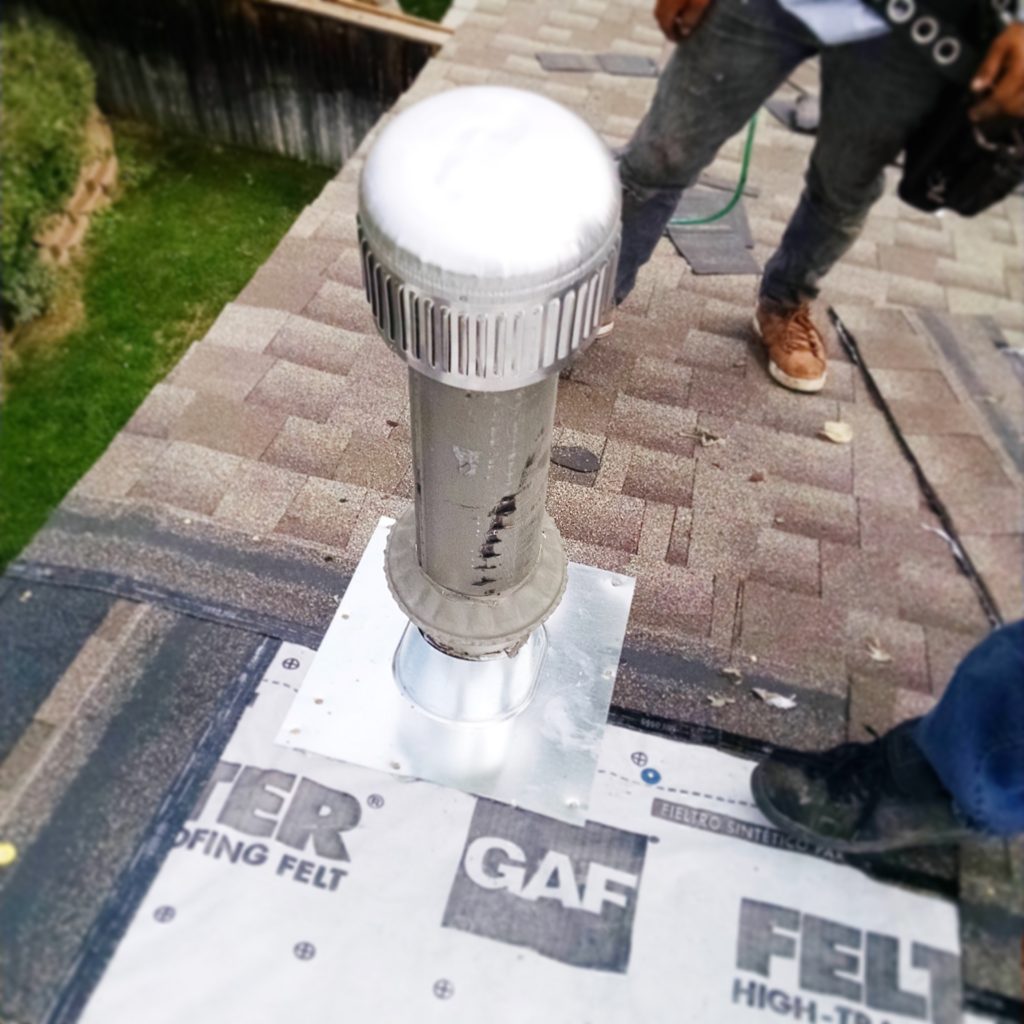Hail Damage Roof Replacement
Pounding hail and wind storms sweeping through Denver Metro have cause severe damage to roofing systems. Insurance companies have categorized June 18, 2018 storm as a catastrophic event. In the coming months homeowners will be dealing with filing insurance claims and hiring a contractor for hail damage roof replacement. One important aspect of the roof system that should be aware of is the possibility of carbon monoxide dangers after a roof replacement.
During a roof replacement flashing around vent stacks, specifically furnace flue pipes and water heater flue pipes, if located through the roof, can unintentionally cause a carbon monoxide leak. During the tear-off or installation of the roof the flue pipe can become disconnected in the attic area. Thus, carbon monoxide, an odorless gas, can be trapped in your home after roof repairs if not discovered and re-attached properly.
Flue pipes for furnaces, water heaters and other fuel-burning systems which exhaust through the roof need to be checked by a licensed HVAC contractor after a roof replacement.
How roof venting systems work to keep you safe
Venting systems in your home are in place to ensure carbon monoxide and other dangerous gases are safely directed outside. These vent channels typically run from your furnace, water heater, stove, or other gas appliances to the exterior of your home.
Sometimes these channels run through the walls of your home, into the attic and out through the roof, which is where they can be damaged following a severe storm event or subsequently during roof replacement.
Carbon monoxide poisoning poses a real threat
When your is roof repaired or replaced, it’s important to verify that the vents are reconnected to any fuel-burning appliance. If they are left unattached, you and your family can be at risk of carbon monoxide poisoning.
Over 400 American citizens die each year from accidental carbon monoxide poisoning and thousands more are admitted to emergency rooms with carbon monoxide-related sickness from exposure.
Protect your home with these precautions after a storm or roof replacement
Some of these incidents can be easily avoided by taking the following things into consideration:
• Following a severe weather occurrence, check the flue vent piping that ascends from your gas appliances through your home and into the attic to ensure the pipes have not come loose or disconnected
• After a storm, have an experience roofing contractor check the venting exit on the roof to ensure it’s not blocked and is clear of debris.
• If you do find a puncture in the venting system, don’t use tape or any other household materials to patch it yourself. Contact a licensed HVAC professional to properly patch the hole. Improperly patching a hole can lead to a carbon monoxide build up in your home.
• If you have the roof replaced or repaired on your home, have a licensed HVAC technician to inspect the venting afterwards. A roofer is not qualified to perform this type of inspection, therefore, as a courtesy and to ensure your safety your roofing contractor should help you coordinate this inspection.
• Ensure that repairs and maintenance are performed by a reputable and licensed plumber or HVAC technician. They have the experience and knowledge to properly fix and install components safely, so you and your family don’t become victims of carbon monoxide poisoning.
Hail Damage to Furnace Caps
Because of their location, it is a misconception that furnace caps and flue pipes through the roof can be handled by a roofing contractor. Repairs to furnace caps, which are commonly damaged during a hail storm, should be carried out by a licensed HVAC technician. Furnace caps which are installed incorrectly or too far down onto the flue pipe could obstruct venting, trapping noxious combustion gases within the home.
During roof replacement CIG Construction takes every precaution to keep homeowners safe
When roof replacement is complete CIG Construction’s trained foreman examines all flue pipes. Following every roof replacement CIG Construction contracts a licensed HVAC sub-contractor to perform a thorough inspection in the attic area to ensure all flue pipe connections are intact and safely venting through the roof. As an added safeguard, with every roof replacement CIG Construction gives each homeowner a free carbon monoxide detector.
If you have the roof replaced or repaired on your home, have a licensed HVAC technician to inspect the venting afterwards. A roofer is not qualified to perform this type of inspection, therefore, as a courtesy and to ensure your safety your roofing contractor should help you coordinate this inspection.
Hail Damage to Furnace Caps
Because of their location, it is a misconception that furnace caps and flue pipes through the roof can be handled by a roofing contractor. Repairs to furnace caps, which are commonly damaged during a hail storm, should be carried out by a licensed HVAC technician. Furnace caps which are installed incorrectly or too far down onto the flue pipe could obstruct venting, trapping noxious combustion gases within the home.
During roof replacement CIG Construction takes every precaution to keep homeowners safe
When roof replacement is complete CIG Construction’s trained foreman examines all flue pipes. Following every roof replacement CIG Construction contracts a licensed HVAC sub-contractor to perform a thorough inspection in the attic area to ensure all flue pipe connections are intact and safely venting through the roof. As an added safeguard, with every roof replacement CIG Construction gives each homeowner a free carbon monoxide detector.


